Chem 210
Arizona State University
All 29 results
Sort by

-
CHEM 210 Exam 3 Reagents exam with complete solutions
- Exam (elaborations) • 4 pages • 2023
-
- $15.99
- + learn more
H-X CCl4 ADD STRONG ACIDS, -hydrohalogens - Mark w H-shift + cat. (X= Cl, Br, I) SYN+ANTI H2O H2SO4 ADD WEAK ACIDS, -hydration -Mark SYN + ANI Cl2, Br2, I2 CCl4 ADD X2 (Cl, Br, I), halogenation ANTI Cl2, Br2, I2 H2O / R-OH ADD halogen and OH halohydrin ANTI 1) NCS, NBS, NIS 2) H2O / R-OH ADD halogen and OH halohydrin ANTI H-OX/ R-OX (X=Cl, Br, I) ADD halogen (X) and OH halohydrin ANTI 1) BH3 2) NaOH, H2O2 ADD OH and H hydrobo...
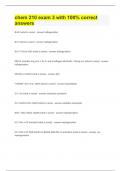
-
chem 210 exam 3 with 100% correct answers
- Exam (elaborations) • 2 pages • 2023
-
- $12.99
- + learn more
Br-Br (what is name) hallogenation Br-Cl (what is name) hallogenation Br-Cl / OH or H2O (what is name) hallogenation NBS (5 member ring w N, 2 2x O, and a hallogen attached) / strong nuc (what is name) hallogenation KMnO4 or OSO4 (what is name) diol "MCPBA" (R-C=O & -OOH) (what is name) epoxidation O3 / Zn (what is name) reductive ozonolysis O3 / NaOH, H2O, H2O2 (what is name) oxidative ozonolysis BH3 / H2O, H2O2, NaOH (what is na...

-
CHEM 210- EXAM 1- CHAPTERS 10, 11, 12, 13, and 14 + QUIZZES /PP QUESTIONS AND ANSWERS
- Exam (elaborations) • 2 pages • 2023
-
Available in package deal
-
- $14.99
- + learn more
Choose the most CORRECT property of an organic compound. A) low boiling point B) high melting point C) conducts current D) flammable E) A and D Answer: E) A and D A) Low boiling point AND D) Flammable Which of the following compounds will have double bond(s) in it? A) octane B) heptyne C) benzene D) A and C E) A and B Answer: D) A)Octane AND C)Benzene What is the molecular formula of cyclohexane? A) C6H8 B) C6H12 C) C6H10 D) C6H14 Answer: B) C6H12 ...
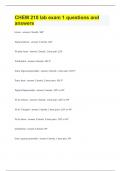
-
CHEM 210 lab exam 1 questions and answers
- Exam (elaborations) • 2 pages • 2023
-
Available in package deal
-
- $15.49
- + learn more
Linear 2 bonds, 180° Trigonal planar 3 bonds, 120° Tri-plan; bent 2 bonds, 1 lone pair, 120° Tetrahedral 4 bonds; 109.5° Tetra; trigonal pyramidal 3 bonds, 1 lone pair; 109.5° Tetra; bent 2 bonds, 2 lone pairs; 109.5° Trigonal bipyramidal 5 bonds; 120° or 90° Tri bi; seesaw 4 bonds, 1 lone pair; 120° or 90° Tri bi; T-shaped 3 bonds, 2 lone pairs; 120° or 90° Tri bi; linear 2 bonds, 3 lone pairs: 120° or 90° ...
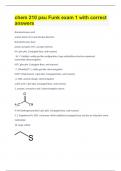
-
chem 210 psu Funk exam 1 with correct answers
- Exam (elaborations) • 10 pages • 2023
-
Available in package deal
-
- $13.99
- + learn more
Bronsted-Lowry acid proton donor (H+) and donates Electron Bronsted-Lowry base proton acceptor (H+), accepts electron HI ( give pKa, Conjugate Base, and reasons) -10, I^-(iodide), noble gas like configuration, large orbitals(less electron repulsion) somewhat electronegative HCl ( give pKa, Conjugate Base, and reasons) -7, Chloride(Cl^-), noble gas-like, electronegative H3O^+(Hydronium)- ( give pKa, Conjugate Base, and reasons) -2, H2O, neutral charge, electroneg...

-
Chem 210 Exam II with complete solutions already graded A+
- Exam (elaborations) • 6 pages • 2023
-
Available in package deal
-
- $13.99
- + learn more
electrophiles electron seeking reagents that have room to accept a electron pair nucleophiles reagents seeking a nucleus to which to donate a pair of electrons proton transfer or protonation reaction the transfer of a proton from one base to another transition state lying between the products and reactants free energy of activation (delta G double dagger) the height of the barrier, the energy that the reactants attain in reaching the the transition state e...
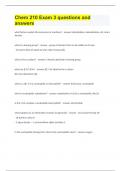
-
Chem 210 Exam 3 questions and answers
- Exam (elaborations) • 11 pages • 2023
-
Available in package deal
-
- $14.99
- + learn more
what factors explain the outcomes of reactions? hybridization, delocalization, eN, atom density what is a leaving group? - group of atom(s) that can be stable on its own - eN atoms that are good LG also make strong acids what is the α carbon? C directly attached to leaving group what are β Cs? β Hs? βC: C(s) attached to α carbon βH: H(s) attached to βC what is a LB? is it a nucleophile or electrophile? lewis base, nucleophile what is nucleophilic ...

-
Chem 210 Exam 2 with complete verified solutions
- Exam (elaborations) • 3 pages • 2023
-
Available in package deal
-
- $13.49
- + learn more
Ammonium NH4+ Hydronium H30+ Mercury (I) Hg2(2+) Acetate C2H3O2(-) Azide N3(-) Carbonate CO3(2-) Chlorate ClO3(-) Chlorite ClO2(-) Chromate CrO4(2-) Cyanide CN(-) dichromate Cr2O7(2-) dihydrogen phosphate H2PO4(-) Hydrogen carbonate (bicarbonate) HCO3(-) hydrogen phosphate HPO4(2-) hydrogen sulfate (bisulfate) HSO4(-) Hydroxide OH(-) Hypochlorite ClO(-) Nitrate ...

-
chem 210 exam 3 with all questions correctly answered
- Exam (elaborations) • 5 pages • 2023
-
Available in package deal
-
- $13.49
- + learn more
less the more s character a carbocation has, the _____stable it is the same as when looking at an epoxide, the orientation around the oxygen is _________ the orientation around the double bond in the reactant BrOH when added with base makes an epoxide Br2 adds 2 Brs in anti conformation lindlar catalyst produces a Z alkene from an alkyne (adds 2 Hs in syn) add more electronegative atom, add pi bond 2 ways of producing an oxidation reaction remove e...
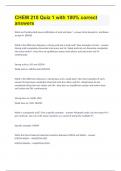
-
CHEM 210 Quiz 1 with 100% correct answers
- Exam (elaborations) • 2 pages • 2023
-
Available in package deal
-
- $14.49
- + learn more
What are the Bronsted-Lowry definitions of acid and base? Acids donate H+ and Bases accept H+ (BAAD) What is the difference between a strong acid and a weak acid? Give examples of each. Strong acids completely dissociate into anion and H+. Weak acids do not dissociate completely into anion and H+, they form an equilibrium system and reform acid and anion and H+ continuously. Strong acid ex. HCl and H2SO4 Weak acid ex. H3PO4 and HC2H3O2 What is the difference between a strong ...

How did he do that? By selling his study resources on Stuvia. Try it yourself! Discover all about earning on Stuvia


